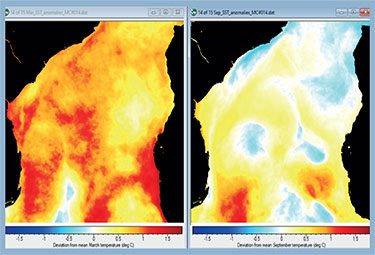
|
Using monthly SST anomaly data to explore inter-annual variability |

|

Screenshot from the lessons showing sea surface temperature anomalies for March and September 2016. Eddies can be seen as warm and cold deviations from the climatological mean, particularly in the September image (right).
In most regions of the world the seasonal cycle is the strongest signal revealed by time series analysis.
Inter-annual variability is less marked, but can be very important for understanding environmental variability and change.
Monthly anomalies are deviations from the climatological mean, and shows us how each of the twelve months differ from what would be expected if there were no inter-annual variability.
This short tutorial shows how to use Bilko in Batch mode to calculate monthly SST anomalies for each month from 2003 to 2017, and looks at some ways to explore the variability that the anomaly data reveal.
Learning objectives
By the end of the lesson you should be able to
- select a region of interest and note the coordinates for use in batch mode
- convert SST data from Kelvin (used in MURSST data) to Centigrades (Celsius)
- use Bilko in batch mode to calculate SST anomalies from a monthly climatology and a time series of monthly SST data
- select an appropriate stretch and colour palette to display anomaly data
Full lesson in PDF format
Download data and tools to complete the lesson
 Previous: Calculating an SST climatology
Previous: Calculating an SST climatology
|
Last update: 19 January 2021 | Contact |  |
Site Policy |



